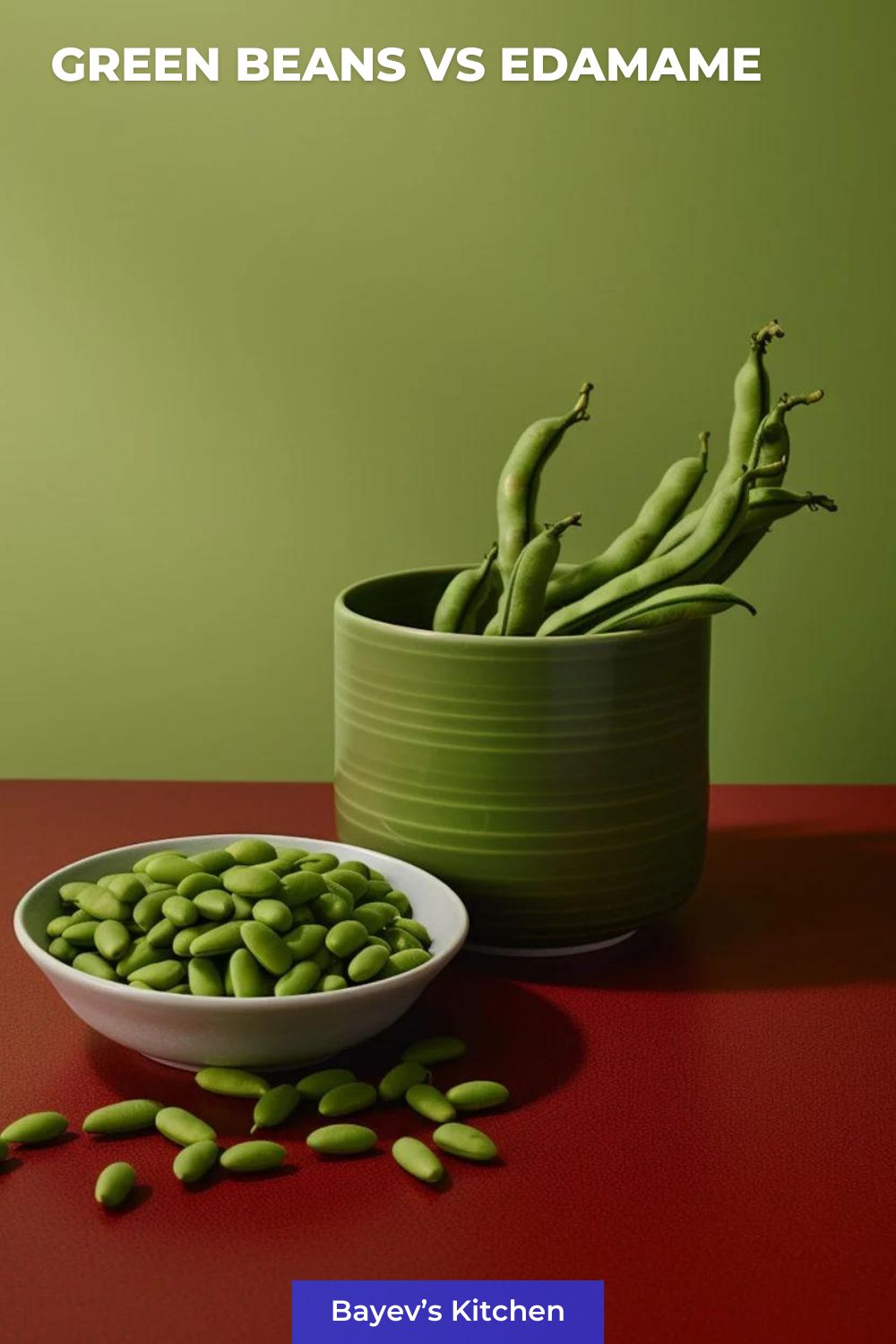Within the extensive array of the vegetable world, green beans and edamame represent two nutritious and delicious options that are cherished by many. While at first glance they might seem similar, they have unique characteristics that set them apart, especially when it comes to their culinary uses and nutritional content. Let’s dive into the intriguing comparison of green beans and edamame.
Main Differences
When we look at green beans and edamame, we’re comparing two different types of beans at two different stages of maturity. Green beans, also known as string beans, are the young, unripe fruit and protective pods of various cultivars of the common bean. They are often consumed whole, pod included.
Edamame, on the other hand, are immature soybeans, harvested before hardening and often found in the pod. Unlike green beans, only the seeds of edamame are typically eaten, not the pod.
Flavor & Taste
The taste profiles of green beans and edamame are another area where these two beans differentiate themselves. Green beans have a delicate, sweet flavor and a crisp, succulent texture. They are versatile and mix well with a wide range of other ingredients.
Edamame, conversely, has a mild, slightly nutty flavor, with a firm but creamy texture when cooked. They’re often boiled or steamed and served with a sprinkle of sea salt, making them a favorite snack or appetizer in many Asian cuisines.
Nutrition Comparison
| Nutritional Aspect | Green Beans (per 100g) | Edamame (per 100g) |
|---|---|---|
| Calories | 31 | 122 |
| Protein | 1.8g | 11g |
| Fat | 0.1g | 5g |
| Carbohydrates | 7g | 9.9g |
| Fiber | 3.4g | 5g |
| Sugars | 3.3g | 2g |
| Calcium | 37mg | 63mg |
| Iron | 1.03mg | 2.27mg |
25 Facts about Differences and Similarities
Fact 1: Origins
Green beans originated in Central and South America, whereas edamame is native to East Asia, specifically China and Japan.
Fact 2: Availability
Green beans are widely available year-round in fresh, canned, and frozen forms. In contrast, edamame is often found in the frozen section and less commonly available fresh.
Fact 3: Culinary Uses
Green beans are used in a wide range of dishes, from salads to stews, while edamame is a popular snack in Asian cuisine and a great addition to salads and stir-fries.
Fact 4: Preparation
Green beans are typically topped, tailed, and may be left whole or cut into pieces for cooking. Edamame is usually boiled or steamed in its pod and then shelled before eating.
Fact 5: Cooking Time
Green beans cook quickly, usually in less than 10 minutes, while edamame requires a longer cooking time, often around 15-20 minutes.
Fact 6: Nutritional Content
Edamame boasts a higher protein content, making it an excellent choice for vegetarians and vegans. Green beans, though lower in protein, are an excellent source of vitamins A, C, and K.
Apologies for the oversight, here are the additional facts:
Fact 7: Shelf Life
While both green beans and edamame can last for about a week when fresh, edamame tends to have a longer shelf life when frozen.
Fact 8: Versatility in Dishes
Both beans are versatile in cooking, fitting well into various cuisines worldwide.
Fact 9: Dietary Restrictions
Both green beans and edamame are suitable for a wide range of diets, including vegan, vegetarian, gluten-free, and dairy-free diets.
Fact 10: Allergy Concerns
While green bean allergies are relatively rare, soy, including edamame, is a common allergen.
Fact 11: Glycemic Index
Both green beans and edamame have a low glycemic index, making them a good choice for people managing their blood sugar levels.
Fact 12: Vitamins and Minerals
Both beans are packed with various vitamins and minerals. Green beans are rich in Vitamin C and Folate, while edamame excels in providing Vitamin K and Iron.
Fact 13: Texture
Green beans have a crisper texture, while edamame is more tender and buttery.
Fact 14: Popularity in Different Cuisines
Green beans are widely used in western cooking, while edamame is a staple in Asian cuisines.
Fact 15: Protein Content for Vegans
Edamame, being high in protein, serves as an excellent plant-based protein source for vegans and vegetarians.
Fact 16: Fiber Content
Both green beans and edamame are high in dietary fiber, supporting digestive health.
Fact 17: Growing Conditions
Green beans prefer a sunny, well-drained spot, while edamame thrives in a variety of soil types.
Fact 18: Harvesting
Edamame is harvested while the beans are still young and green, whereas green beans can be picked throughout the growing season.
Fact 19: Omega-3 Fatty Acids
Edamame is a source of Omega-3 fatty acids, beneficial for heart health.
Fact 20: Sodium Content
Edamame contains more sodium than green beans, especially if salt is added during the cooking process.
Fact 21: Antioxidant Properties
Both green beans and edamame contain antioxidants, although the types and amounts differ.
Fact 22: Color
While both are green, the shade of green varies, with edamame usually being a darker green than most varieties of green beans.
Fact 23: Taste Raw
Green beans can be enjoyed raw, while edamame needs to be cooked before eating.
Fact 24: Plant Family
While both are types of legumes, green beans belong to the Phaseolus genus, while edamame belongs to the Glycine genus, meaning they come from different plant families.
Fact 25: Snacking
Edamame, often served with a sprinkle of salt, is a popular snack in its own right. In contrast, green beans are not commonly consumed as a stand-alone snack but rather as a part of meals.
Conclusion
In summarizing our exploration into green beans and edamame, it is clear that both these legumes bring an array of nutritional benefits and versatility to our culinary experiences. They both stand strong in their unique features, from their varied vitamin and mineral content to their differing flavors and textures, both serving as a robust base for many different kinds of dishes.
Edamame, with its buttery texture and high protein content, is a mainstay in Asian cuisine and increasingly popular worldwide. It’s a powerhouse of vitamins and minerals like Vitamin K and Iron and serves as a great source of plant-based protein for vegetarians and vegans. The higher levels of omega-3 fatty acids in edamame also contribute to its heart-health benefits, and its low glycemic index makes it suitable for people managing blood sugar levels. However, one must be aware of the higher sodium content and potential allergenic properties due to its status as a soy product.
On the other hand, green beans, with their bright color and crunch, are familiar sights on Western dinner plates. They are lower in calories and are packed with Vitamin C and Folate. They are also versatile and can be enjoyed both raw or cooked, adding a dash of color and freshness to a variety of dishes. They are less allergenic than edamame, making them a safer choice for those with specific food sensitivities.
As we consider these factors, it’s evident that both green beans and edamame have their unique strengths and can be chosen based on personal preference, dietary requirements, and the specific flavors and nutritional content you are looking for. Regardless of your choice, both of these legumes can play a key role in a balanced, health-conscious diet, adding both flavor and nutrient density to your meals. They remind us of the beauty of nature’s bounty, each bringing their unique colors, textures, and tastes to enrich our culinary palette.
So, whether you’re looking to shake up your salad with some crunchy green beans, or you’re keen on adding a protein punch to your stir-fry with some edamame, it’s safe to say that both these legumes are worthy additions to your kitchen. And who knows? Perhaps your next culinary adventure could include a surprising combination of both!

